
Last Update: Friday November 21, 2025
Thinking of a holiday trip that combines vibrant festivities with perfect weather? Look no further than Christmas in Vietnam. While it's not a traditional public holiday here, the festive spirit lights up major cities like Hanoi and Ho Chi Minh City, offering a lively and often surprising Vietnam Christmas experience that transcends religious boundaries. This guide explores why December is a great time for Vietnam travel, what makes the holiday so unique, and essential tips for navigating your journey, from Vietnam visas to Vietnam airport services during Christmas.
In Vietnam, Christmas is primarily a beloved cultural and commercial celebration—a lively excuse for friends, family, and couples to enjoy the vibrant atmosphere and city decorations.
Though Vietnam has a significant Catholic population that attends Midnight Mass (especially at places like St. Joseph’s Cathedral in Hanoi or Notre Dame in HCMC), the holiday is embraced by nearly everyone. For the majority, it's a popular night out:
Dazzling Decorations: Shopping malls, streets, and businesses in urban centers like District 1 of Ho Chi Minh City compete with each other to put up the most stunning displays of lights, tinsel, and elaborate Christmas trees.
The Motorbike Cavalcade: A uniquely Vietnamese tradition sees families and young people taking to the streets on their motorbikes on Christmas Eve to soak in the lights and enjoy the festive chaos.
Social Event: Christmas Eve (Đêm Giáng Sinh) is the main event, marked by gatherings, celebratory meals, and couples exchanging gifts, making it one of the most romantic nights of the year.
Food is central to the celebration. While some hotels and international restaurants offer traditional Western turkey and Yule log, you'll also find Vietnamese families enjoying celebratory feasts that include:
Fusion Dishes: A mix of local favorites like Phở or Bánh Xèo alongside Western-style desserts.
Street Snacks: Street vendors selling roasted chestnuts and other warm snacks add to the cozy holiday vibe in the cooler northern cities.

Photo: Collected
December marks the beginning of the prime travel season for many parts of Vietnam, offering a mix of climates perfect for a diverse itinerary.
South Vietnam (HCMC, Phu Quoc): Enjoys its best weather with dry, sunny skies, low humidity, and temperatures around 24°C to 32°C (75°F to 90°F)—ideal for beach days.
North Vietnam (Hanoi, Ha Long Bay): Offers a crisp, cool "winter" with temperatures ranging from 15°C to 22°C (59°F to 72°F). It’s perfect for exploring the capital's Old Quarter without excessive heat.
Central Vietnam (Da Nang, Hoi An): The end of the rainy season means the second half of December often brings drier, cooler weather, making the central coast more pleasant.
December is considered a peak tourist season in Vietnam, especially late in the month due to Christmas and New Year's.
Expect a moderate influx of tourists, particularly in major cities and popular beach areas like Phu Quoc.
The actual crowds for Christmas celebrations on the evening of the 24th are mostly local, creating a dense, exciting, street-party atmosphere in city centers.
Tip: Book accommodations and tours early, especially for travel between December 20th and January 5th, as popular areas fill up fast.
Since December is a peak time, having your logistics in order is key to a smooth start to your Vietnam travel.
As Christmas is not a public holiday, government offices and immigration services operate as usual, but the volume of travelers is higher.
E-Visa is Recommended: To avoid long queues, apply for your Vietnam E-Visa online well in advance. This allows you to bypass the often-slow Visa On Arrival (VOA) process entirely, as it's approved before you fly.
Passport Validity: Ensure your passport is valid for at least six months after your intended date of entry.
Peak season means immigration lines can be very long at major hubs like Noi Bai (Hanoi) and Tan Son Nhat (HCMC).
Consider Fast-Track: If you are using a Visa on Arrival (VOA) or simply want to speed through immigration during the busy holiday period, many services offer an Airport Fast Track option for a fee. This service meets you on arrival and escorts you through a dedicated line to expedite passport control.
|
Destination |
Vibe |
Highlight |
|
Ho Chi Minh City |
Energetic, Commercial, Warm |
Spectacular street decorations in District 1, bustling Midnight Mass at Notre Dame Cathedral. |
|
Hanoi |
Charming, Cooler, Traditional |
Festive lights around Hoàn Kiếm Lake, deep cultural atmosphere near St. Joseph's Cathedral. |
|
Phu Quoc Island |
Tropical, Relaxing, Beach |
Beachside Christmas dinners and parties under clear, sunny skies. |
|
Sapa/Dalat |
Cool, Misty, Mountainous |
A unique, quiet Christmas in the highlands, sometimes with a rare chance of frost. |
Whether you need a fast visa, airport fast track, private car, or eSIM, Vietnam-Immi.org is here 24/7 to support your trip.
Whatsapp: +84379522522
Hotline: +84.379.522.522
Email: sales@vietnam-immi.org
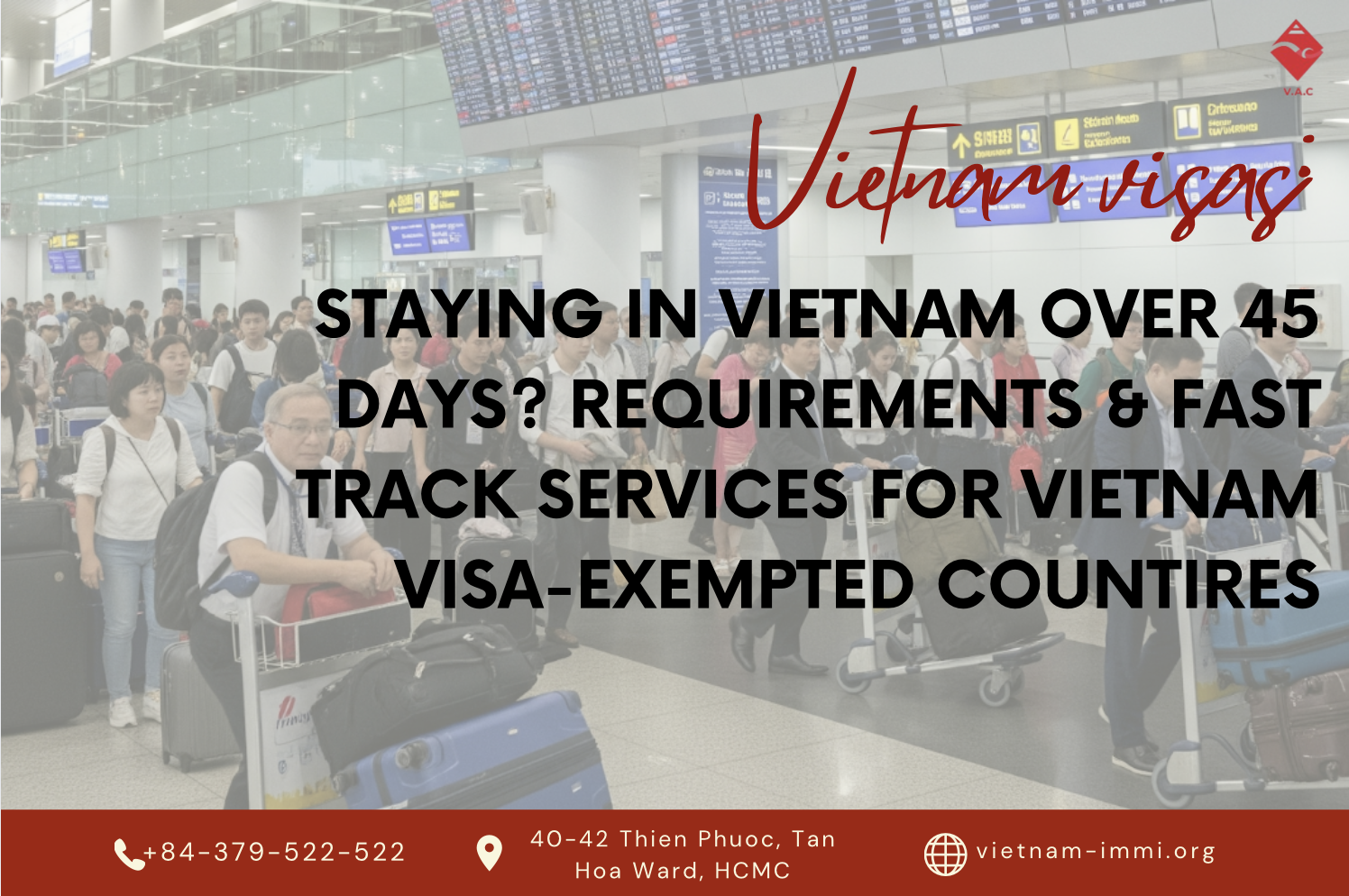
Last update: Wednesday November 19, 2025
On August 8, 2025, the Government of Vietnam officially issued Resolution No. 229/NQ-CP, granting visa-free entryfor citizens of 12 European countries. This policy reflects Vietnam’s strong commitment to revitalizing tourism, promoting cultural exchanges, and strengthening economic cooperation.
Validity Period: August 15, 2025 – August 14, 2028
Maximum Stay: Up to 45 days per entry
Eligibility: Citizens holding any passport type, provided standard entry requirements are met
Primary Purpose: Tourism travel
Travelers can benefit from visa-free entry if they meet the following conditions:
A passport valid for at least six months from the date of entry.
Confirmed round-trip tickets with a stay of fewer than 45 days.
Visitors from the following nations will now enjoy simplified access to Vietnam:
Belgium, Bulgaria, Croatia, the Czech Republic, Hungary, Luxembourg, the Netherlands, Poland, Romania, Slovakia, Slovenia, and Switzerland.
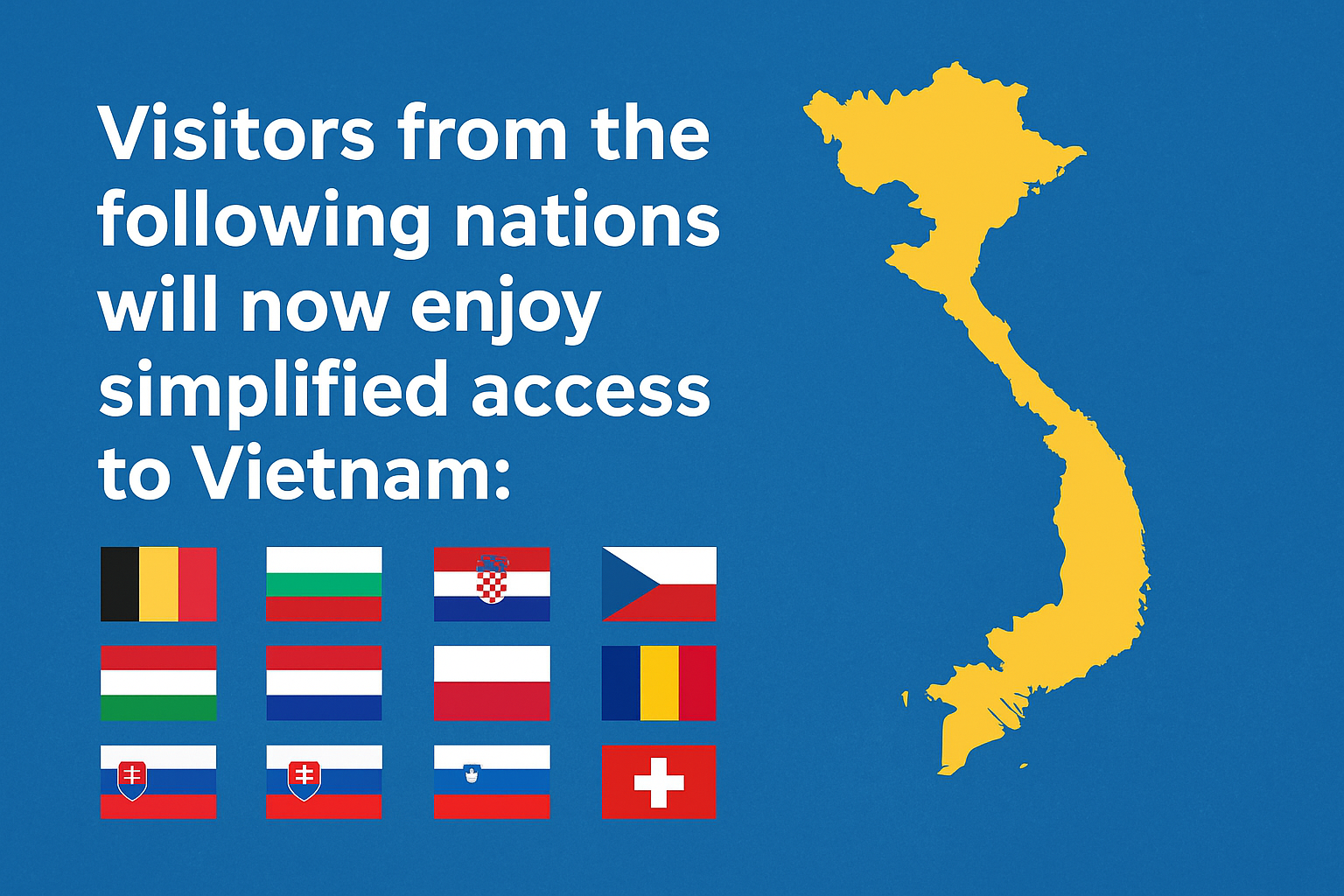
If you intend to stay beyond 45 days or enter Vietnam for business purposes, a visa is required. Our team can assist you with:
Vietnam visas (tourist, business, urgent processing available).
Urgent visa applications for travelers needing quick turnaround.
Pro tips: Please double check with your sponsor company in Vietnam and keep copies of your entry documents (visa, exemption approval, Fast Track booking) for smooth airport procedures.
Even if you are eligible for visa exemption, certain immigration procedures may still apply upon arrival. To avoid long queues and unnecessary stress, we recommend our Arrival Fast Track Service:
Dedicated airport staff meet you upon landing.
Priority assistance at immigration counters.
Support with all entry procedures, ensuring you pass through smoothly.
Tailored help for visa-exempt travelers, so you won’t encounter difficulties related to your exemption status.
With Fast Track, you can save valuable time and start enjoying Vietnam right away.
This policy is a major step in Vietnam’s tourism stimulus program, particularly aimed at attracting European visitors. With hassle-free entry and expanded stay duration, exploring Vietnam’s breathtaking landscapes, vibrant culture, and world-class hospitality has never been easier.
Contact us and let us know your travel plans! Whether you’re coming for leisure or business, our team is here to support you with the latest Vietnam visa updates, urgent visas, and Fast Track airport services.
Have a visa or Fast Track question? We’ll provide the answer.
Yes. The visa exemption only applies for tourism purposes. For business meetings, work, or official events, you will need to apply for the appropriate business visa.
No. If you plan to stay longer than 45 days, you have one option of applying for a visa before your exemption period ends.
Even if you don’t need a visa, our Arrival Fast Track service ensures you skip long immigration lines, get priority assistance, and handle any special procedures required for visa-exempt entries.

Photo: Collected
Last Update: Wednesday November 12, 2025
Planning a trip to Vietnam in 2025? Whether you’re visiting for tourism, business, or long-term stay, understanding the Vietnam entry requirements and visa procedures is essential. This guide walks you through everything you need to know — from how to enter Vietnam legally to extending your stay in Vietnam smoothly.
Quick summary:
Vietnam welcomes travelers from over 80 countries with various visa and visa-free options.
Check your eligibility and prepare documents in advance.
Complete your entry procedures correctly to avoid delays at the airport.
For the latest visa support and updates, visit vietnam-immi.org.
Step 1 — Check the Latest Vietnam Entry Requirements (2025)
Before booking your flight, review the latest Vietnam entry requirements.
As of 2025, Vietnam grants visa-free entry (ranging from 14 to 45 days) to travelers from countries such as Japan, South Korea, Germany, France, Italy, Spain, the UK, and several ASEAN nations.
Pro Tips: Always check the updated exemption list before traveling. Even if you’re exempt, you must hold a valid passport with at least 6 months’ validity and proof of onward travel.
Vietnam’s e-Visa system is the easiest and fastest way to enter the country. You can apply online and receive your approval within 3–5 working days.
Valid for 90 days (single or multiple entry)
Accepted at 42 international checkpoints, including major airports like Tan Son Nhat (Ho Chi Minh City), Noi Bai (Hanoi), and Da Nang.
Apply and get help with your e-Visa process via vietnam-immi.org.
Step 2 — How to Enter Vietnam: Airport Procedures
When you arrive at a Vietnamese airport, you’ll go through three main steps.
For e-Visa holders: Proceed directly to the immigration counter and present your passport, printed e-Visa, and arrival card (if required).
For visa-on-arrival: Go to the “Visa on Arrival” desk before the immigration area, submit your approval letter, passport, photos, and stamping fee (in USD).
Declare any items exceeding duty-free limits. Most travelers pass through smoothly, but make sure not to carry restricted goods.
After clearing immigration, you’re officially in Vietnam! Here’s what to keep in mind during your stay.
Hotels and registered hosts automatically report your stay to local immigration authorities. If you stay in a private home or Airbnb, ensure your host registers your temporary residence.
Keep both printed and digital copies of your passport and visa.
Respect local laws and regulations; overstaying can result in fines.
Travel with travel insurance covering medical and trip interruptions.
Use reliable visa support services to avoid fraudulent websites.
For professional visa assistance and updates, contact vietnam-immi.org.
Q1: How early should I apply for a Vietnam e-Visa?
It’s best to apply at least 1–2 weeks before your travel date to allow for processing time and possible revisions.
Q2: Can I extend my Vietnam visa while in the country?
Yes. You can extend your visa without leaving Vietnam through the immigration office or a trusted service agency such as vietnam-immi.org.
Q3: What happens if I overstay my visa?
Overstaying can lead to fines or future entry restrictions. Always renew or exit before your visa expires.
Entering and staying in Vietnam in 2025 is straightforward — as long as you follow the correct steps and stay informed about Vietnam entry requirements. Whether you’re visiting for a short trip or a longer adventure, proper preparation ensures a smooth and enjoyable experience.
✨ For personalized visa assistance and the latest updates on Vietnam travel 2025, visit vietnam-immi.org.
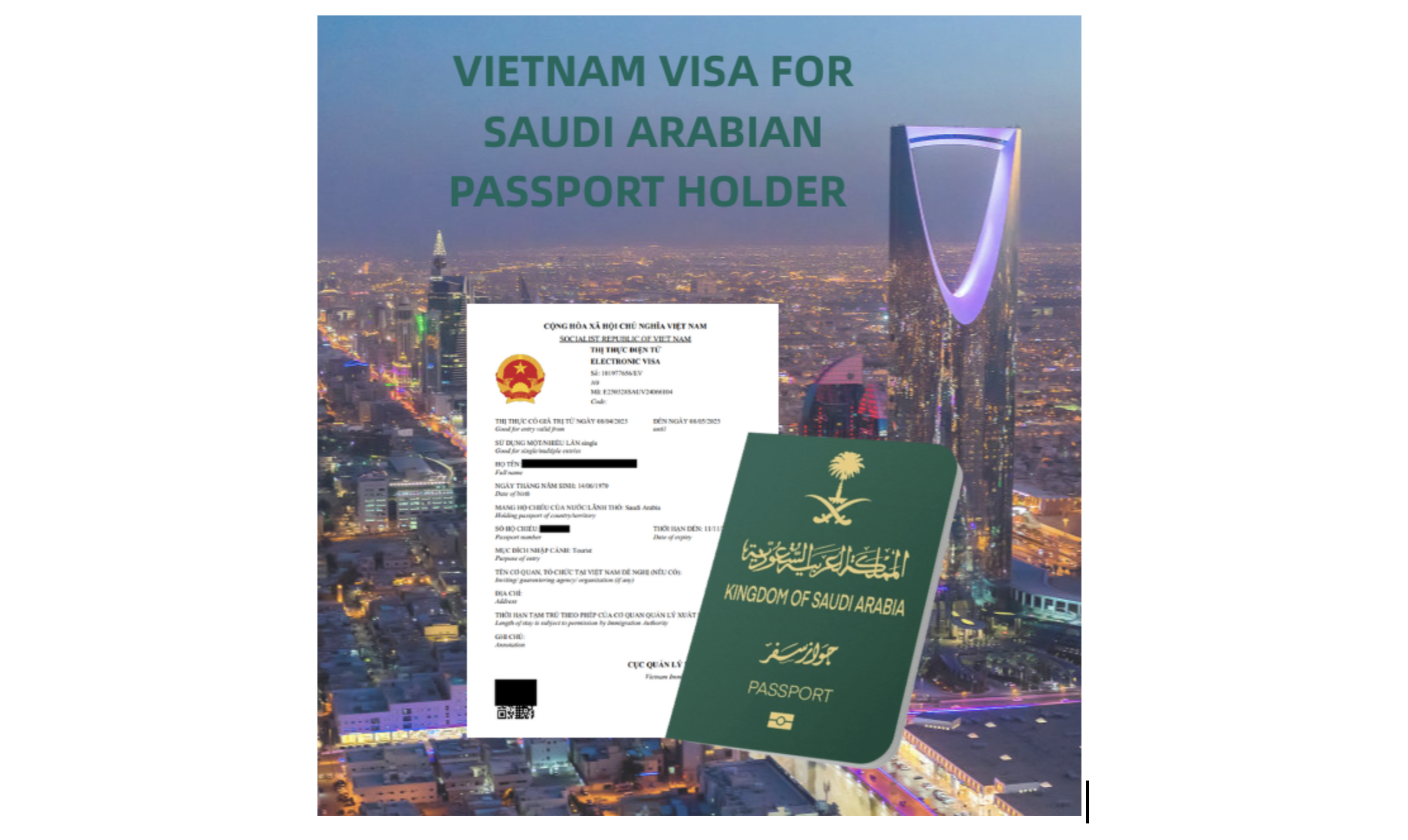
Last Update: Monday November 10, 2025
Planning a spontaneous trip to Vietnam from Saudi Arabia? Getting a Vietnam visa doesn’t have to be complicated — even if it’s last minute.
If you are a Saudi Arabian passport holder planning a trip to Vietnam, please note that a valid visa is mandatory for entry. If time is of the essence, this comprehensive guide from Vietnam-immi.org explains exactly how to obtain an Express Visa quickly and efficiently. We’ll walk you through the process, highlight the documents required, entry procedures, the applicable visa fees, and tips to make the process smoother.
Before applying, it’s essential to understand that Saudi Arabia is not on Vietnam’s visa exemption list. This means all Saudi citizens need a valid visa to enter Vietnam, regardless of the length of stay or purpose of travel.
There are three main visa options for Saudi passport holders:
E-Visa (Electronic Visa) — Available for tourism and short business trips.
Apply fully online via the official Vietnam Immigration website or a trusted agency.
Standard processing: 3–5 working days; express options available for urgent cases.
Visa on Arrival (VOA) — Travelers can obtain a Visa on Arrival at Vietnam’s international airports by presenting a Visa Approval Letter issued in advance.
Only available for air arrivals.
Requires printed approval letter, passport, photo, and stamping fee at the airport.
Embassy/Consulate Visa — Apply directly at the Vietnam Embassy in Saudi Arabia for standard or long-term visas. This option will take the processing time from 5–7 working days.
An Express Vietnam Visa is a visa application designed for travelers who need urgent approval — often within 4 - 2 working hours, or even 30 minutes for emergency cases. This service is particularly useful for Saudi citizens who need to fly to Vietnam on short notice.
Go to Vietnam-immi.org and select E-Visa under the list of services.
Fill out the application form with your personal details, passport and portrait photo, entry date to Vietnam …
Choose your preferred processing option — the expedited processing time
Pay the service fee
Track your application status via the website or email.
Once approved, you’ll receive your eVisa by email — print it out or keep as digital file and bring it along for your trip.
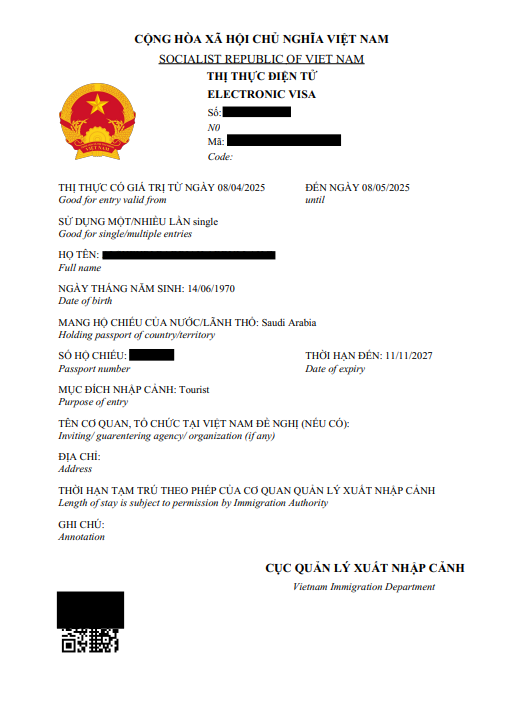
To ensure a smooth and quick approval, Saudi Arabia passport holders should prepare the following documents:
A valid Saudi passport (valid at least 6 months and have at least 2 blank pages)
A digital passport photo (Photo taken no more than 6 months ago, jpeg format, size ≤ 2MB, straight looking, no hat, no glasses, polite clothes.).
A scanned copy of the passport’s biographical page.
Printed Visa Approval Letter (from Vietnam Immigration or an authorized agency).
Passport (valid at least 6 months and have at least 2 blank pages)
Two passport-sized photos (4x6 cm).
Completed entry/exit form (NA1) — available online or at the airport.
Visa stamping fee (in cash, USD preferred).
Once you arrive at one of Vietnam’s international airports (Noi Bai, Tan Son Nhat, or Da Nang…), follow these steps:
Go to the Visa on Arrival Counter.
Present your passport and visa. If you are using a Visa on Arrival, you must also provide your approval letter, passport photos, and a completed NA1 entry form.
Pay the Visa Stamping Fee.
This fee applies only to the Visa on Arrival. The amount varies depending on your visa type — typically USD 25 for a single-entry visa or USD 50 for a multiple-entry visa.
Receive Your Visa Stamp.
After payment, immigration officers will issue your visa and stamp your passport. Double-check your visa details for accuracy before leaving the counter.
Proceed to Passport Control.
With your visa stamped, continue to immigration clearance and then collect your baggage.
Proceed to Passport Control.
With your visa stamped, continue to immigration clearance and then collect your baggage.
Visa fees can vary depending on the visa type, processing time, and how you apply.
It’s best to double-check the exact fee with the agency you’re applying through, as prices may change slightly based on service options or exchange rates.
Below is our visa service fee for Saudi Arabian passport holders, provided for your reference.
For Evisa:
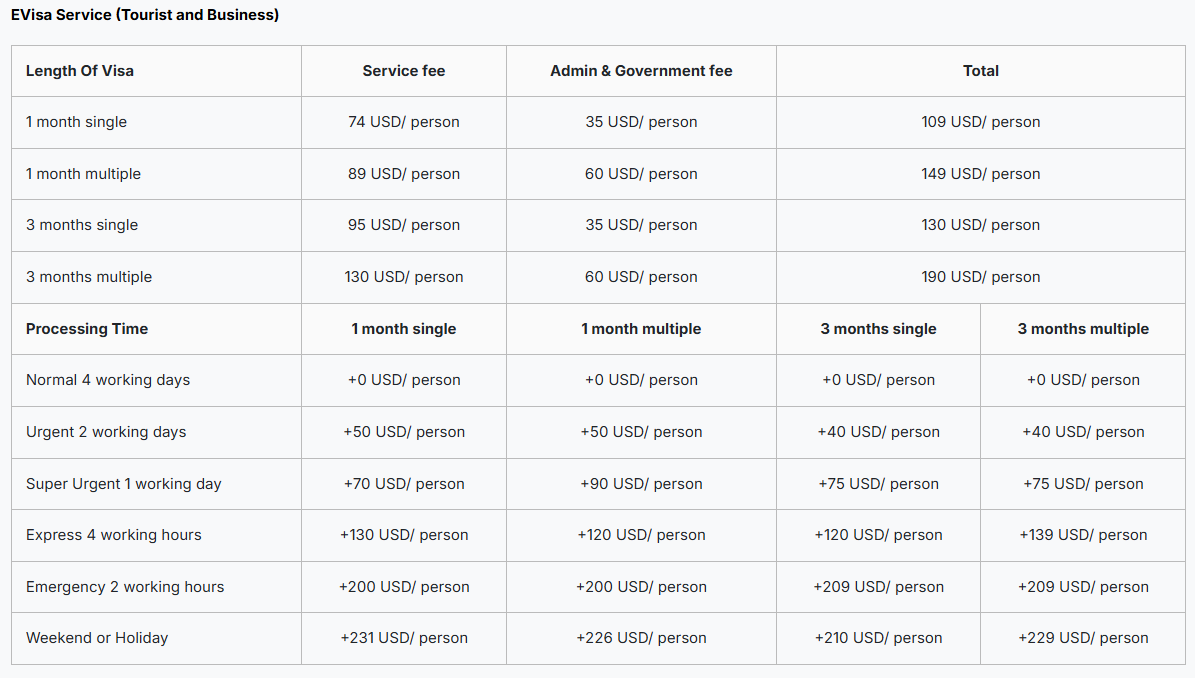
For VOA (Visa on Arrival):
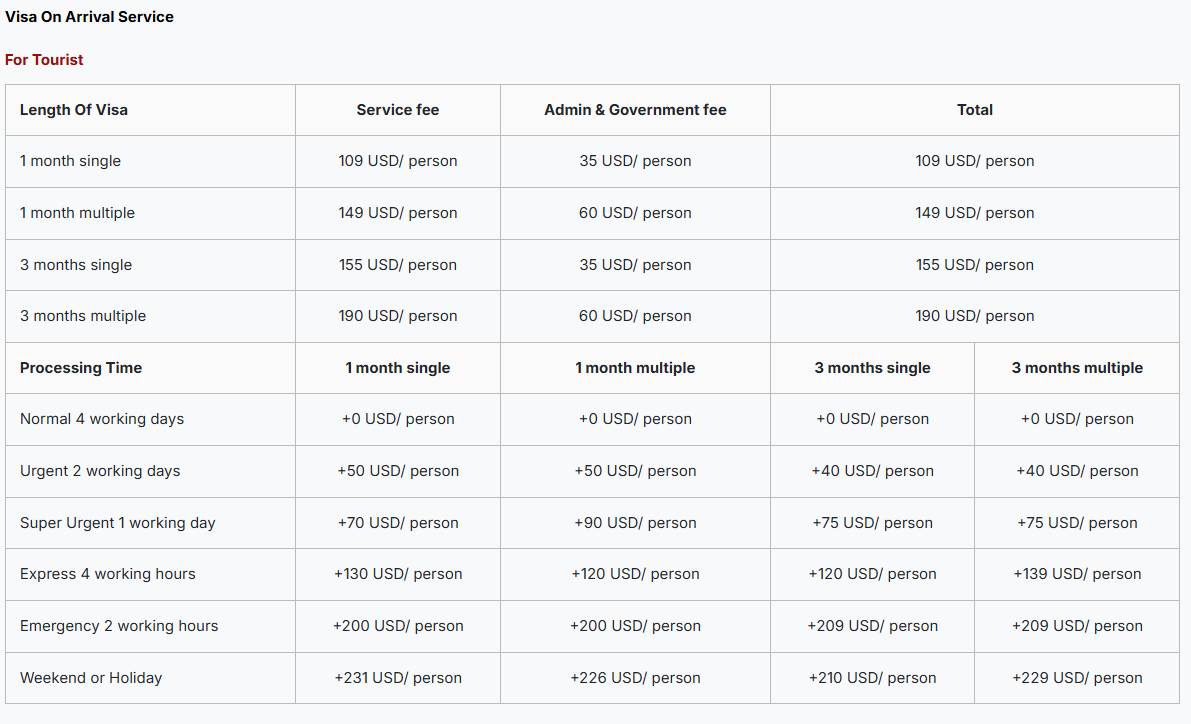
If you have any questions or need assistance, please feel free to contact us:
Hotline: +84 379 522 522
Email: sales@vietnam-immi.org
Missing information or unclear photos are the top reasons for visa delays. Double-check all files before submitting.
Digital copies on your phone may not be accepted at the airport. Always print your Visa Approval Letter.
Remember: the E-Visa is approved before travel and doesn’t require payment at the airport, while the Visa on Arrival needs an approval letter plus an airport stamping fee.
For Saudi Arabia passport holders, obtaining a Vietnam visa — even at the last minute — is fast and straightforward with the right information. Whether you apply for an E-Visa or choose the Visa on Arrival, make sure your documents are complete, your passport is valid, and you understand the entry procedures and visa fees.
By following these steps, you’ll save time, avoid stress, and be ready to enjoy everything Vietnam has to offer — from its rich culture and cuisine to its breathtaking landscapes.